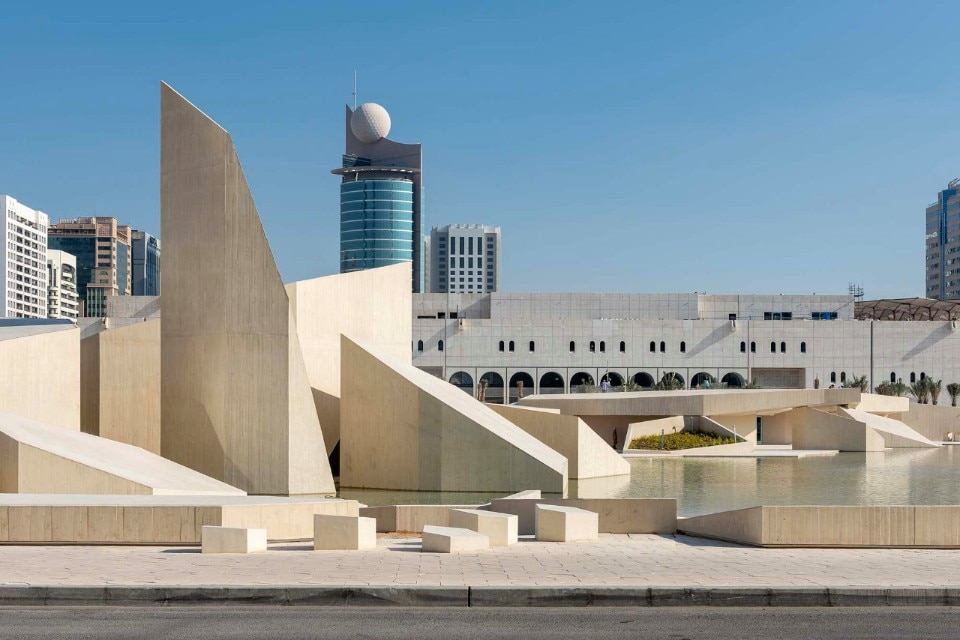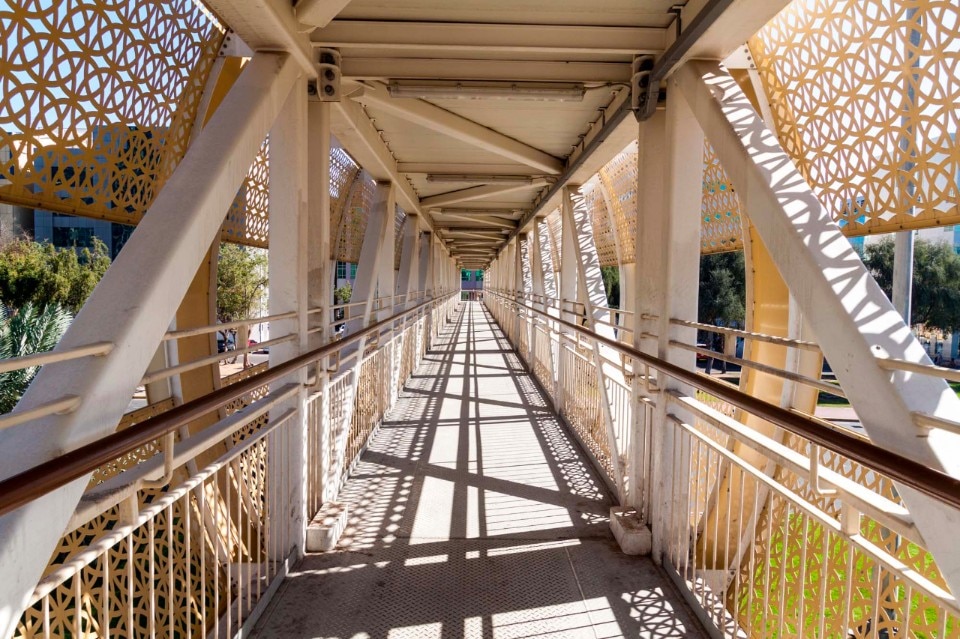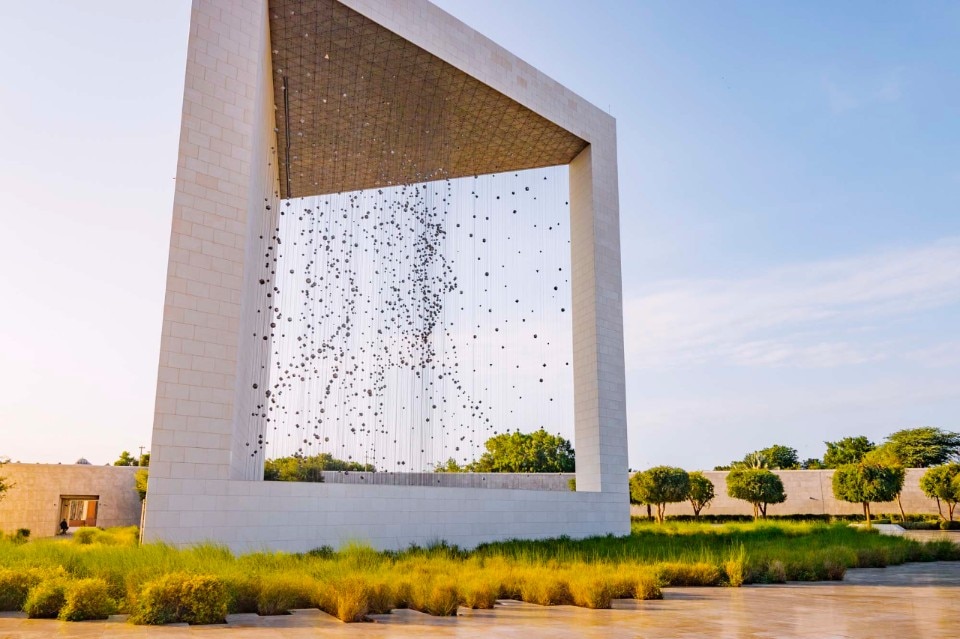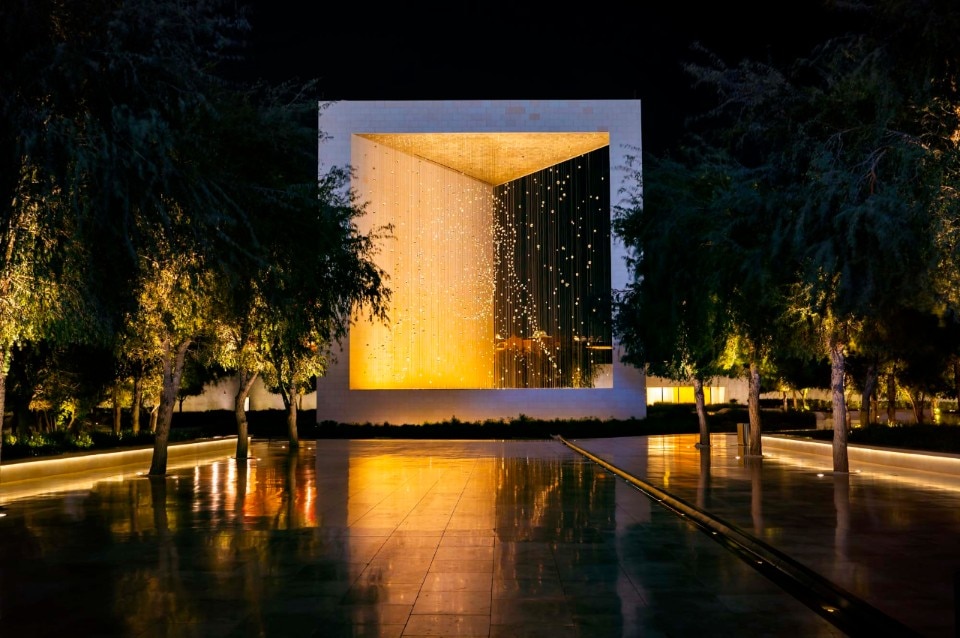by Chiara Testoni
In Abu Dhabi the history is recent and rapidly changing. Over the last fifty years the country has transformed from a pearl fishing village into a leading capital on the world geopolitical scene; from a Bedouin center into a melting pot in which flows of people from all over the world intertwine; from a provincial place buried in the desert (while Dubai was already becoming noticed) into an artistic-cultural stage of international appeal.
The structure of the city was shaped by the vision of the “founding father” Sheikh Zayed bin Sultan Al Nahyan who established the Federation of the United Arab Emirates in 1971, presiding over it first and establishing its capital in Abu Dhabi. Fascinated by rapid and massive expansion, the Sheikh soon rejects the “measured” solutions (on the model of European garden cities) of the first designers in charge of the Abu Dhabi masterplan (Harris, Halcrow & Partners, 1961) and entrusts the project to the Japanese Katsuhiko Takahashi. Referring to the Metabolist model of a city in constant evolution, Takahashi establishes the rigorous orthogonal road network of the city starting from two east-west and north-south axes (Sheikh Rashid Bin Saeed Street and Zayed The First Street), interpreting the demand of the Sheik of unlimited and non-hierarchical expansion, and optimization of travel times.
At the end of the 1960s, Takahashi was replaced by the Egyptian architect Abdelrahman Makhlouf who, in his colleague's orthogonal road scheme, implanted the repeatable settlement model of the “super block”: a square district composed on the borders by a tight curtain of multifunctional vertical buildings and, on the interior, by a more rarefied fabric with public spaces, services and residences separated by small lanes (sikkak), where neighborhood relationships are recomposed.
The years following the Sheikh’s death (2004) witnessed a period of lasseiz-faire and sprawling construction, which produced the disappearance of some particularly vivid traces in the collective memory, such as the old fish market and the “historic” souk.
Today Abu Dhabi is finding its own identity between the bustling and flashy Dubai and the introverted and intellectual Sharjah, beyond that apparent desertification of urban sense that can be perceived behind the tinted windows of fast-moving cars, or from the reflections of the city on the glass curtain walls of the office towers, which give the capital of the Emirates the appearance of a metropolis that can be replicated anywhere. An identity that can be grasped in the dense and vibrant urban fabric of downtown, in the dynamic and pervasive socio-cultural scene of Al Saadiyat and Mina Zayed, in the sparkling Corniche and among the desert dunes, where Masdar City projects a city born on oil into a fossil fuel-free future.
01
Downtown: superblock and Brutalism
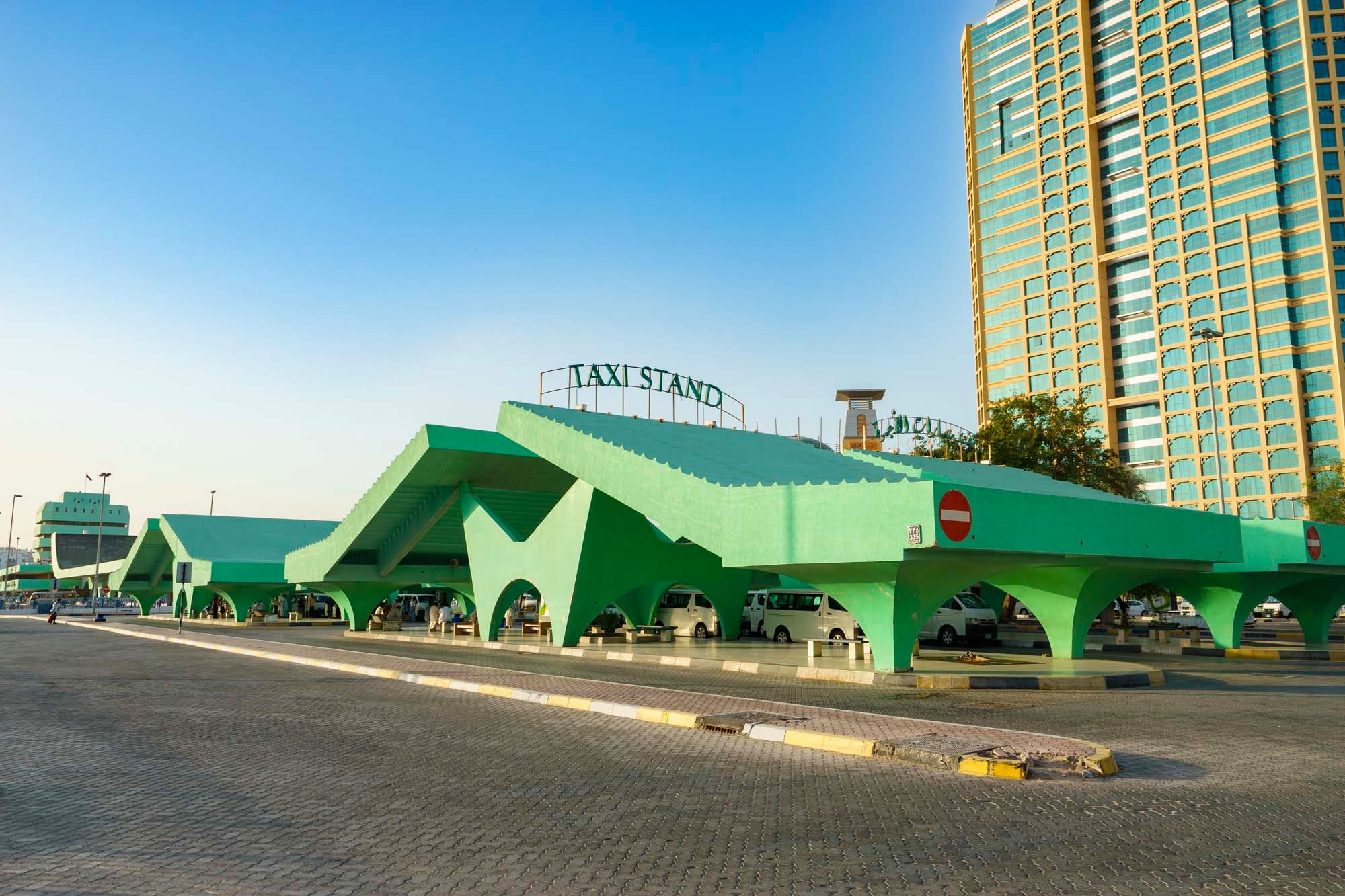
 View gallery
View gallery
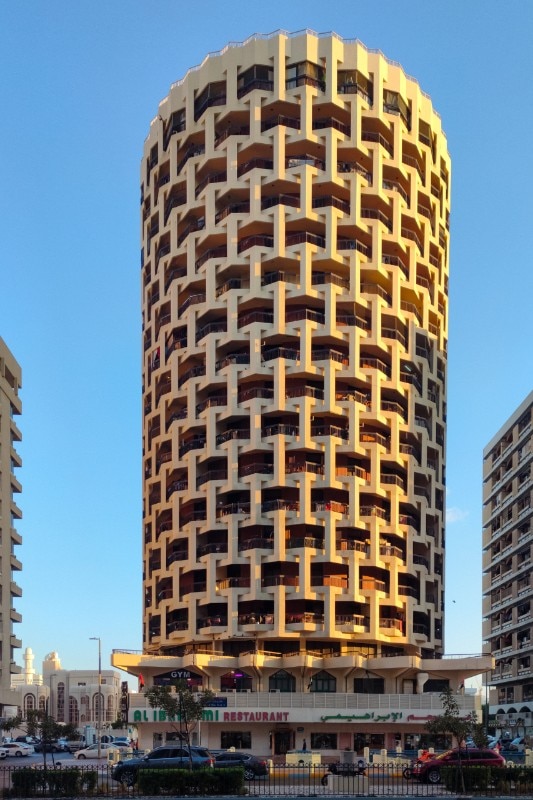
Farouk El Gohary, Al Ibrahimi Tower (Saeed Al Kalili Building), 1989
On Electra Street, Al Ibrahimi Tower is a 16-storey building that stands out for its massive cylindrical volume. On the façade, the cubic modules in reinforced concrete, interlocked and repeated, determine a powerful chiaroscuro effect and suggest the concept evolutionary multiplication inspired by Metabolism.
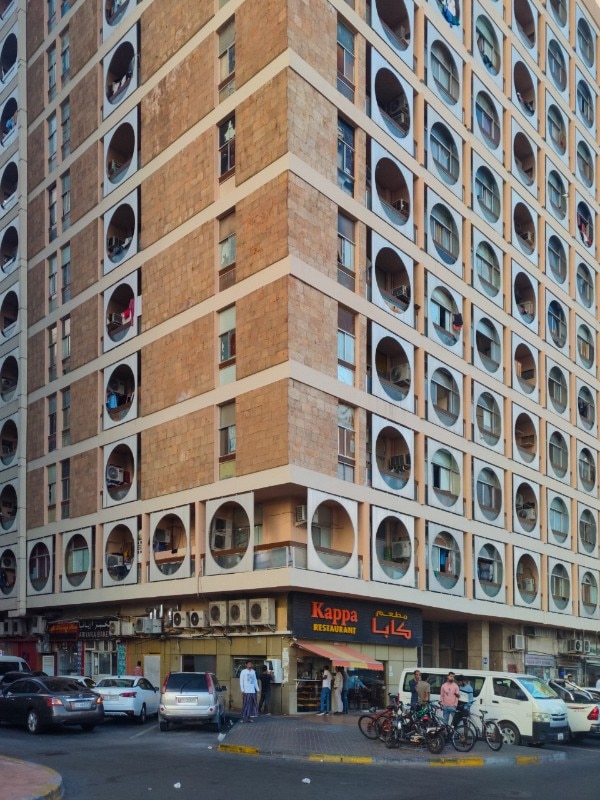
Obeid Al-Mazru’i Building, late 80’s
A little further on, still on Electra Street, Obeid Al-Mazru'i Buildin, set among anonymous glass and aluminum panel buildings, is a cubic volume with a declared Brutalist-style structural grid. The concrete screens with large circular holes frame the balconies in a serial but playful pattern, creating a filter area between the intimacy of the home and the exterior overlooking the street and reinterpreting the traditional mashrabiyya in a modern key.
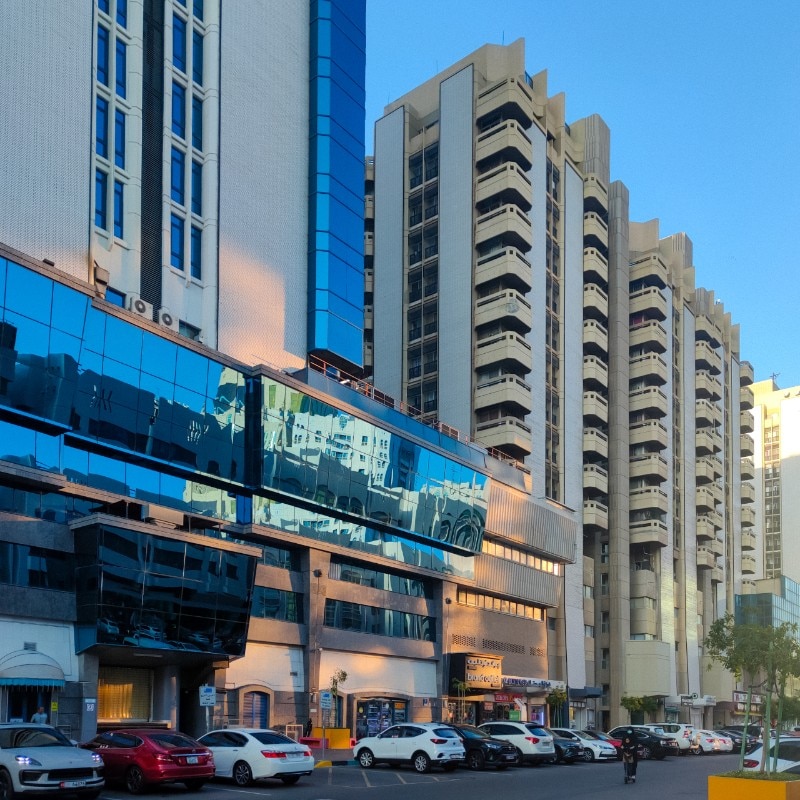
Hamdam Centre, 80’s
Deviating from Electra Street and walking down Hamdam Street, there is Hamdam Centre: a gigantic 1980s monoblock of several towers with a typical grey-beige colour evoking desert sand, connected by a commercial platform (among the first in downtown). This is where the iconic Burger King resides, where Sultan Al Ramahi remembers celebrating his first birthdays and which is still a place strongly experienced by the community.
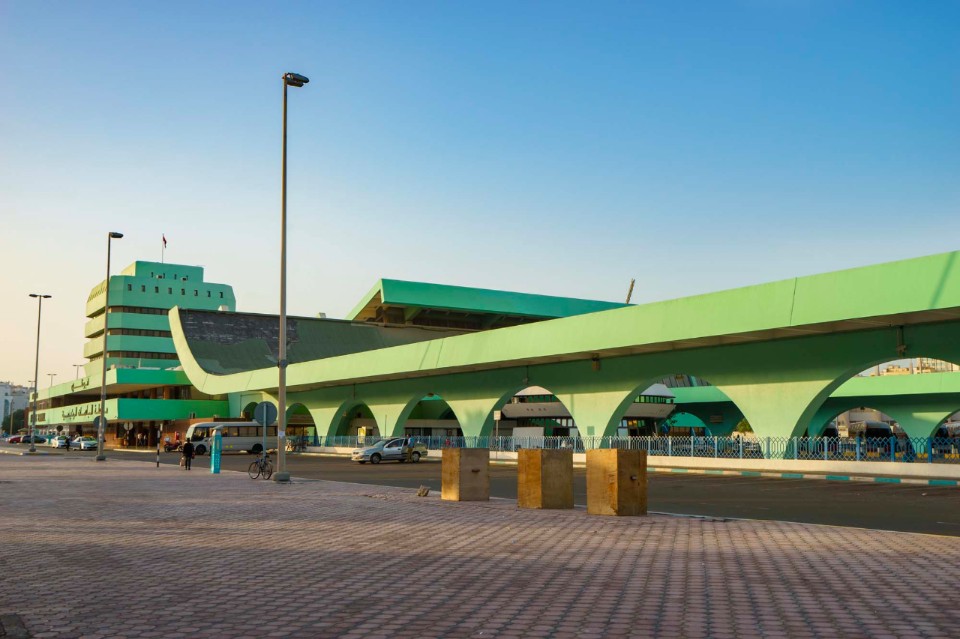
Georgi Kolarov, Abu Dhabi Central bus station, 1989
Located on Sultan Bin Zayed The First Street, the mint-green, Brutalist-inspired sculptural complex with its massive volumes and imposing roof is one of the city's most recognised landmarks, still in full operation today.
Photo Pawel Pajor on Adobe Stock

Farouk El Gohary, Al Ibrahimi Tower (Saeed Al Kalili Building), 1989
On Electra Street, Al Ibrahimi Tower is a 16-storey building that stands out for its massive cylindrical volume. On the façade, the cubic modules in reinforced concrete, interlocked and repeated, determine a powerful chiaroscuro effect and suggest the concept evolutionary multiplication inspired by Metabolism.

Obeid Al-Mazru’i Building, late 80’s
A little further on, still on Electra Street, Obeid Al-Mazru'i Buildin, set among anonymous glass and aluminum panel buildings, is a cubic volume with a declared Brutalist-style structural grid. The concrete screens with large circular holes frame the balconies in a serial but playful pattern, creating a filter area between the intimacy of the home and the exterior overlooking the street and reinterpreting the traditional mashrabiyya in a modern key.

Hamdam Centre, 80’s
Deviating from Electra Street and walking down Hamdam Street, there is Hamdam Centre: a gigantic 1980s monoblock of several towers with a typical grey-beige colour evoking desert sand, connected by a commercial platform (among the first in downtown). This is where the iconic Burger King resides, where Sultan Al Ramahi remembers celebrating his first birthdays and which is still a place strongly experienced by the community.

Georgi Kolarov, Abu Dhabi Central bus station, 1989
Located on Sultan Bin Zayed The First Street, the mint-green, Brutalist-inspired sculptural complex with its massive volumes and imposing roof is one of the city's most recognised landmarks, still in full operation today.
Photo Pawel Pajor on Adobe Stock
The search for urban sense in Abu Dhabi can only start from downtown, the part of the city resulting from the design of Takahashi and Makhlouf. Here, as the architect and designer Sultan Al Ramahi tells Domus, the current settlement typology is that of the superblock. If the buildings within the disctrict have a minute and rarefied fabric, along the main roads the fronts are composed of a tight curtain of “mushroom” multi-storey buildings (narrow base set back from the road front to facilitate transit and reduce the volume on the street), with shops on the ground floor, a mezzanine, offices and apartments on the upper floors. The architectural language is varied and ranges from the aseptic curtain walls in aluminum and glass of the 90s to the Brutalist buildings of the 60s and 80s, sometimes contaminated by Islamic suggestions. Many of these buildings are now listed.
02
Downtown: since the origins to today
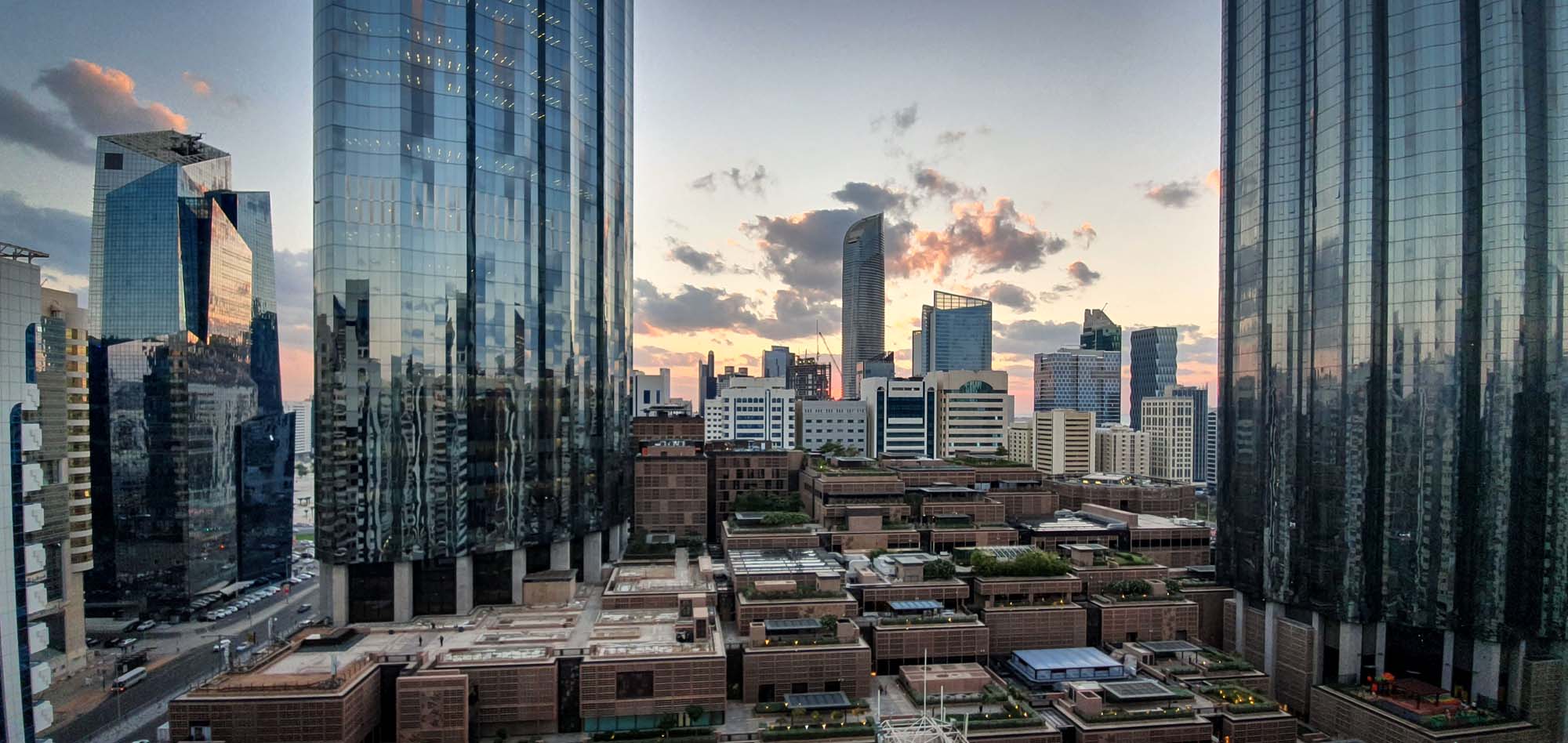
 View gallery
View gallery
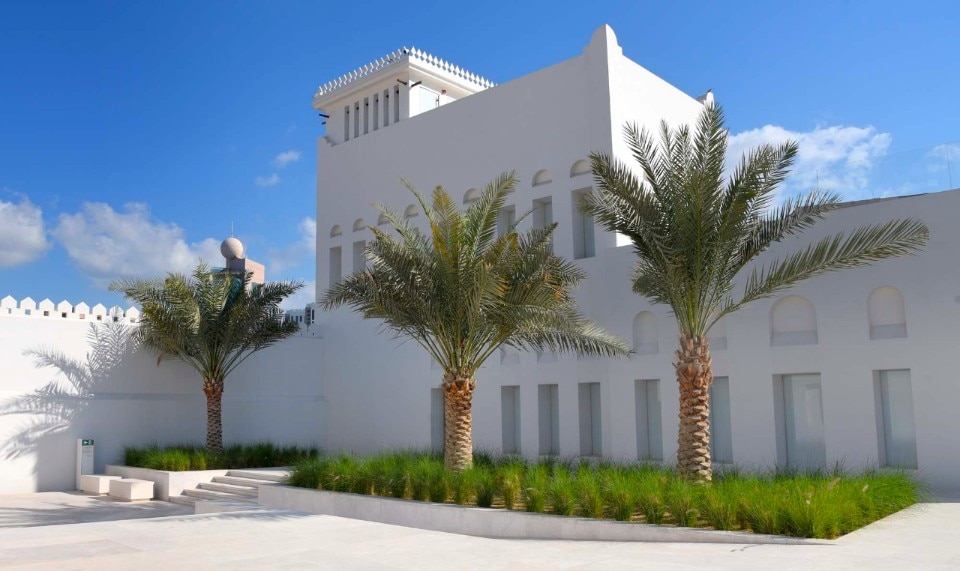
Qasr Al Hosn, 1790
Everything starts from here. It was around this site that the first permanent settlement of the Bani Yas tribe developed in the 18th century, giving rise to the urban evolution of Abu Dhabi. The complex, built in 1790 as a military fort to defend the population and control maritime traffic, has over the years served as a royal residence, seat of institutional power and archive. Enlarged in 1945, it underwent a major renovation that transformed it, in 2018, into a museum where it is possible to learn about the history of the city, from its foundation to contemporary times.
Photo thauwald-pictures via Adobe Stock
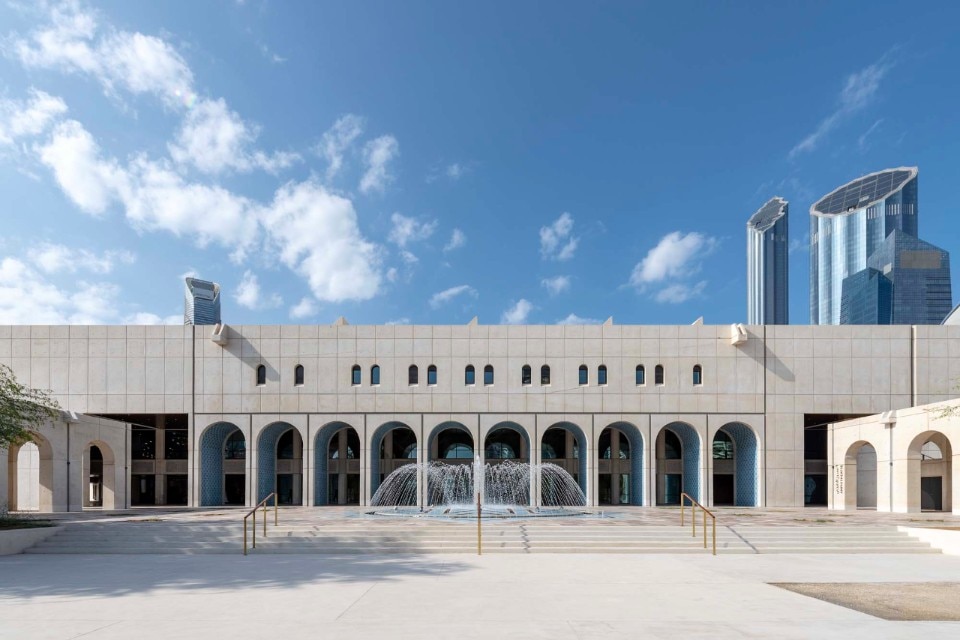
The Architects' Collaborative, Hisham Al Ashkouri, The Cultural Foundation, 1981
The complex, built at the behest of Sheikh Zayed bin Sultan al Nahyan to enhance the region's artistic and cultural heritage, is now a renowned centre that hosts exhibitions, events, an auditorium and the city's first children's library. The building, designed by The Architects' Collaborative (TAC), a group founded by Walter Gropius, and subsequently completed by the Iraqi Hisham Al Ashkouri, is characterised by a modernist language "contaminated" by Islamic suggestions: from the articulation of internal courtyards as the heart of the architecture, to the decorative pattern of the coloured tile cladding.
Photo Mikkel Frost
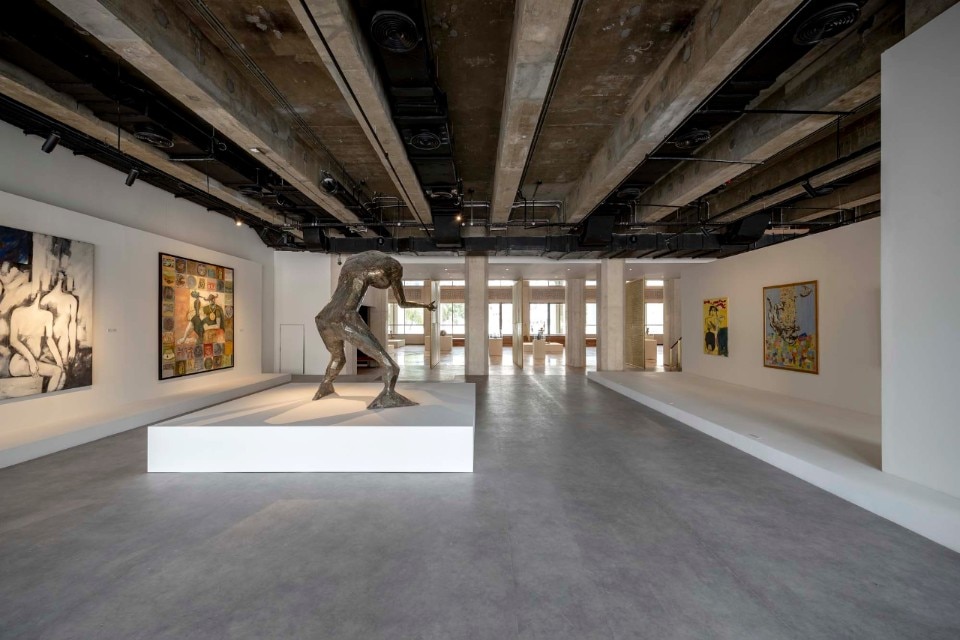
The Architects' Collaborative, Hisham Al Ashkouri, The Cultural Foundation, 1981
The building was recently renovated by the Danish studio CEBRA, which has preserved the materiality and atmosphere of the original building, enriching it with new functions, routes and services.
Photo Mikkel Frost
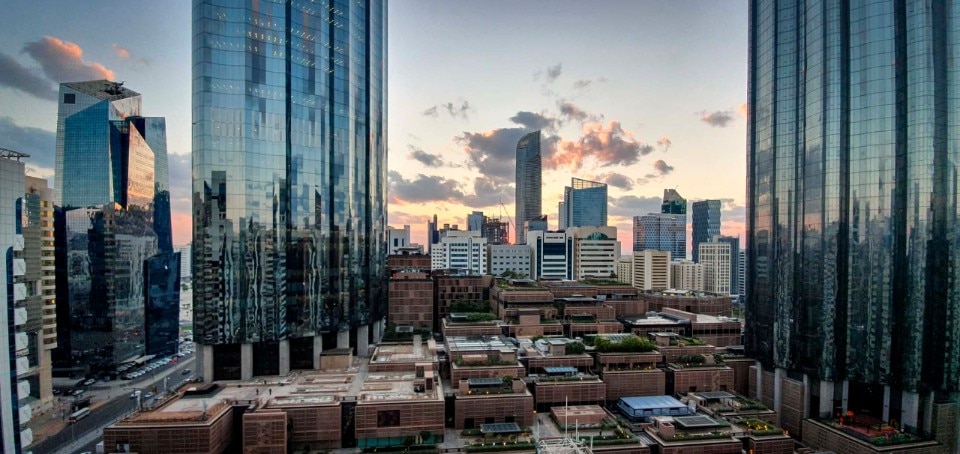
Foster + Partners, World Trade Centre, 2014
Abu Dhabi's central market is one of the city's most historic and beloved sites. Foster's project is located in the area of the demolished old souk, re-proposing its original spirit as a space for commerce and sociality as an alternative to the "aseptic" and globalised typology of the mall. The intervention, inspired by traditional Arab architecture, is arranged in a sequence of squares punctuated by water features, courtyards and internal alleys where changing light filters through the perforated screen of the façade according to the time of day. On the commercial platform, two reflecting surface towers of different height and volume stand out, housing offices, flats and a hotel.
Photo Makaty via Adobe Stock
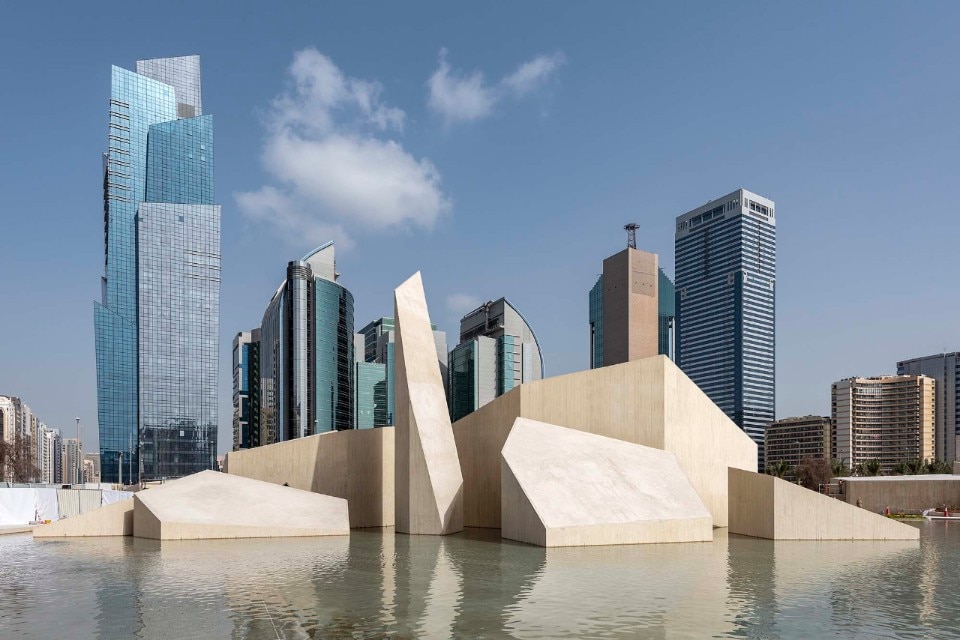
CEBRA, Al Hosn Masterplan, 2019
The area around Qasr Al Hosn was recently redeveloped as part of a masterplan by Danish studio CEBRA, which proposed a figurative lexicon for paths, open spaces, street furniture and planting strongly inspired by the characteristics of the desert landscape. The pedestrian surfaces, dotted with indigenous essences and made of cement that recalls the colour of sand, seem to be cracked by the heat and deconstructed among horizontal walking surfaces and inclined planes that gradually transform into service buildings, for catering and worship. Among these, the "Al Musallah" prayer hall is composed of sculptural and essential volumes, impermeable from the outside and irradiated with light on the inside, resembling fragments of rock emerging from the water.
Photo Mikkel Frost

Qasr Al Hosn, 1790
Everything starts from here. It was around this site that the first permanent settlement of the Bani Yas tribe developed in the 18th century, giving rise to the urban evolution of Abu Dhabi. The complex, built in 1790 as a military fort to defend the population and control maritime traffic, has over the years served as a royal residence, seat of institutional power and archive. Enlarged in 1945, it underwent a major renovation that transformed it, in 2018, into a museum where it is possible to learn about the history of the city, from its foundation to contemporary times.
Photo thauwald-pictures via Adobe Stock

The Architects' Collaborative, Hisham Al Ashkouri, The Cultural Foundation, 1981
The complex, built at the behest of Sheikh Zayed bin Sultan al Nahyan to enhance the region's artistic and cultural heritage, is now a renowned centre that hosts exhibitions, events, an auditorium and the city's first children's library. The building, designed by The Architects' Collaborative (TAC), a group founded by Walter Gropius, and subsequently completed by the Iraqi Hisham Al Ashkouri, is characterised by a modernist language "contaminated" by Islamic suggestions: from the articulation of internal courtyards as the heart of the architecture, to the decorative pattern of the coloured tile cladding.
Photo Mikkel Frost

The Architects' Collaborative, Hisham Al Ashkouri, The Cultural Foundation, 1981
The building was recently renovated by the Danish studio CEBRA, which has preserved the materiality and atmosphere of the original building, enriching it with new functions, routes and services.
Photo Mikkel Frost

Foster + Partners, World Trade Centre, 2014
Abu Dhabi's central market is one of the city's most historic and beloved sites. Foster's project is located in the area of the demolished old souk, re-proposing its original spirit as a space for commerce and sociality as an alternative to the "aseptic" and globalised typology of the mall. The intervention, inspired by traditional Arab architecture, is arranged in a sequence of squares punctuated by water features, courtyards and internal alleys where changing light filters through the perforated screen of the façade according to the time of day. On the commercial platform, two reflecting surface towers of different height and volume stand out, housing offices, flats and a hotel.
Photo Makaty via Adobe Stock

CEBRA, Al Hosn Masterplan, 2019
The area around Qasr Al Hosn was recently redeveloped as part of a masterplan by Danish studio CEBRA, which proposed a figurative lexicon for paths, open spaces, street furniture and planting strongly inspired by the characteristics of the desert landscape. The pedestrian surfaces, dotted with indigenous essences and made of cement that recalls the colour of sand, seem to be cracked by the heat and deconstructed among horizontal walking surfaces and inclined planes that gradually transform into service buildings, for catering and worship. Among these, the "Al Musallah" prayer hall is composed of sculptural and essential volumes, impermeable from the outside and irradiated with light on the inside, resembling fragments of rock emerging from the water.
Photo Mikkel Frost
The route in downtown continues in search of the earliest traces of urban settlement, to explore works that have reshaped the landscape and local identity in recent times.
The “fortress” of Qasr Al Hosn: it all started here. Legend tells that during a hunting session, some nomads of the Bani Yas tribe, thirsty from the desert heat, glimpsed a gazelle and, chasing it, suddenly stumbled upon a spring of fresh water. It was here that they decided to settle, laying the foundations of the first fortified nucleus from which, since the 18th century, the city of Abu Dhabi would develop: a toponym which, in homage to the serendipity of its origin, means “Father of the Gazelle”.
But Qasr al Hosn is not only a monument to the memory of the country; it is also an epicentre propelling lively urban energy, starting from the adjacent complex of The Cultural Foundation (the region's first artistic-cultural centre and today a renowned exhibition and social centre), to the redevelopment of the public areas of the district (by Cebra) that reconnects the fabric of the most representative monuments of the historic city through a contemporary lexicon.
Finally, a look at the contemporary reinterpretation of the ancient souk, now demolished, which revives in the dense and vibrant spirit (typical of places of exchange and relations in Arabic culture) of the World Trade Centre, by Norman Foster.
03
The Corniche

 View gallery
View gallery

DBI - Architects, Etihad Towers, 2011
The Etihad Towers are a clearly recognisable landmark in the urban landscape of Abu Dhabi. The complex is composed of five towers of different heights connected by a platform: one tower houses a luxury hotel, another comprises offices and three are for residential use with a total of 885 flats. The ethereal volumes in reflective glass gently flex upwards, as if shaped by the power of the wind. The Observation Deck at 300m, located on level 74 of the Conrad Abu Dhabi Etihad Towers skyscraper, is the city's highest viewing point, from which to enjoy a cocktail and take in spectacular sights of the Corniche and the Arabian Gulf.
Photo offcaania via Adobe Stock
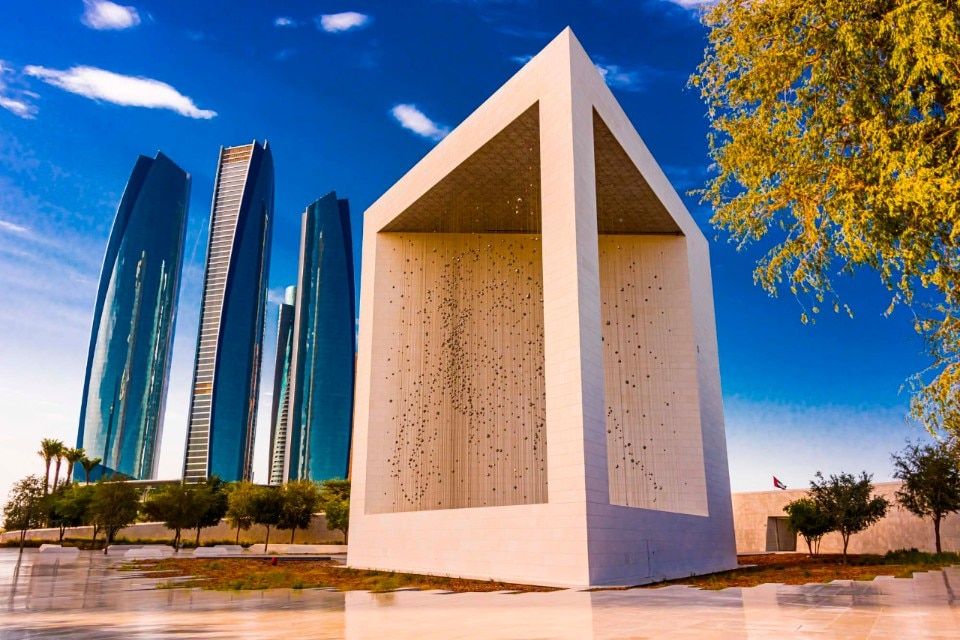
Founder's Memorial
Since Sheikh Zayed's death in 2004, his figure as a foresighted strategist still hovers in the air as the Founder's Memorial suggests. The monument to the memory of the "founding father" consists of a garden planted with typical desert essences and enriched by water features (Heritage Garden), a visitors' centre and a monolithic cubic pavilion (Sanctuary Garden) housing "The Constellation": Ralph Helmick's installation that evokes the Sheikh's face shaped by more than a thousand suspended light points and suggests his ineffable presence, especially after sunset.
Photo Monticellllo via Adobe Stock

DBI - Architects, Etihad Towers, 2011
The Etihad Towers are a clearly recognisable landmark in the urban landscape of Abu Dhabi. The complex is composed of five towers of different heights connected by a platform: one tower houses a luxury hotel, another comprises offices and three are for residential use with a total of 885 flats. The ethereal volumes in reflective glass gently flex upwards, as if shaped by the power of the wind. The Observation Deck at 300m, located on level 74 of the Conrad Abu Dhabi Etihad Towers skyscraper, is the city's highest viewing point, from which to enjoy a cocktail and take in spectacular sights of the Corniche and the Arabian Gulf.
Photo offcaania via Adobe Stock

Founder's Memorial
Since Sheikh Zayed's death in 2004, his figure as a foresighted strategist still hovers in the air as the Founder's Memorial suggests. The monument to the memory of the "founding father" consists of a garden planted with typical desert essences and enriched by water features (Heritage Garden), a visitors' centre and a monolithic cubic pavilion (Sanctuary Garden) housing "The Constellation": Ralph Helmick's installation that evokes the Sheikh's face shaped by more than a thousand suspended light points and suggests his ineffable presence, especially after sunset.
Photo Monticellllo via Adobe Stock
The Corniche is an extremely popular place for the city’s inhabitants, who spend their leisure time on the beach, jogging in the well-kept parks or stopping at the many cafes and restaurants. Here there are some iconic works rooted in the city’s collective memory and in the common imagination that regards Abu Dhabi as an international capital of towering and glittering representative architecture.
04
Al Saadiyat and Mina Zayed: the stages of culture
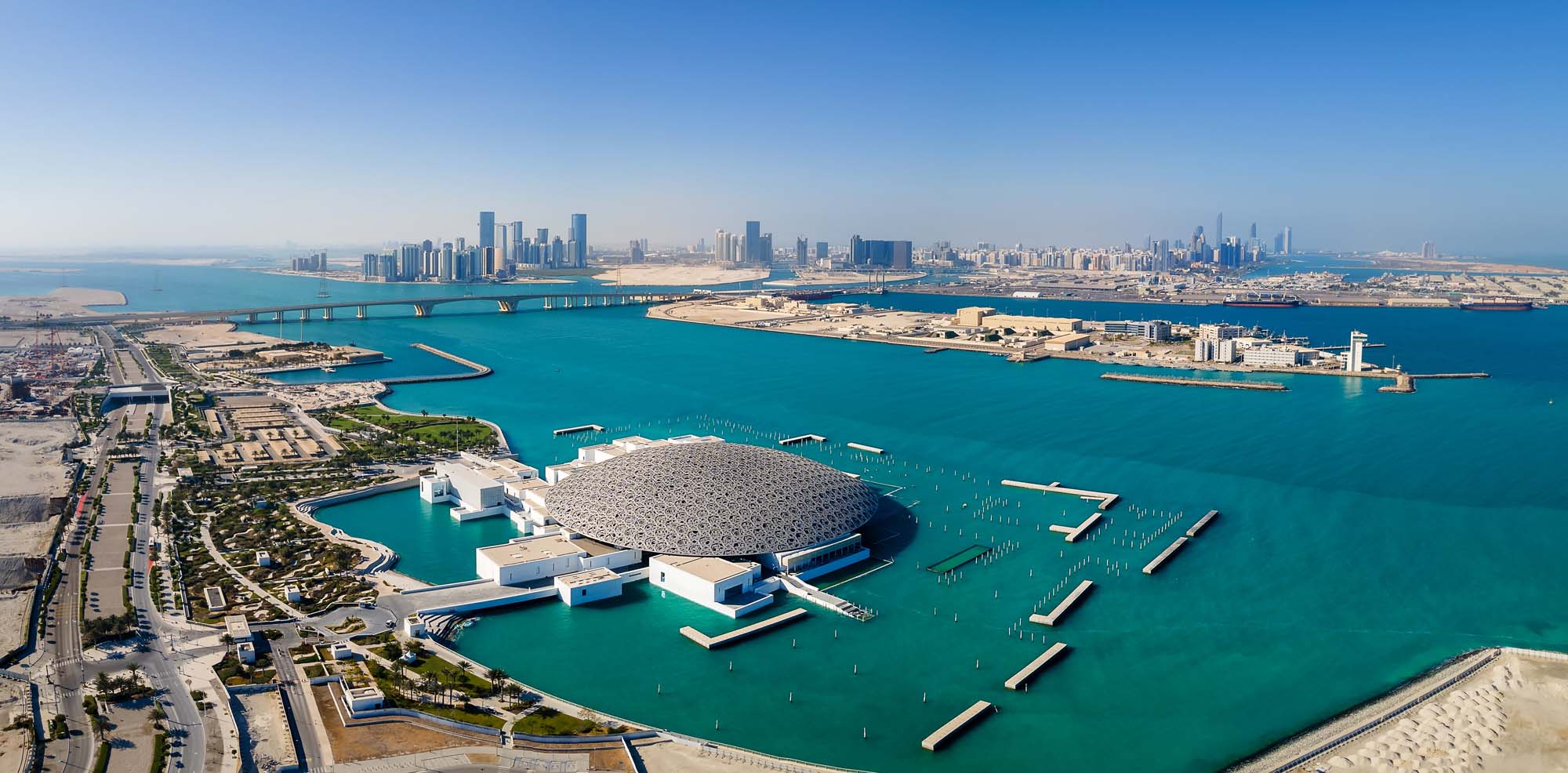
 View gallery
View gallery
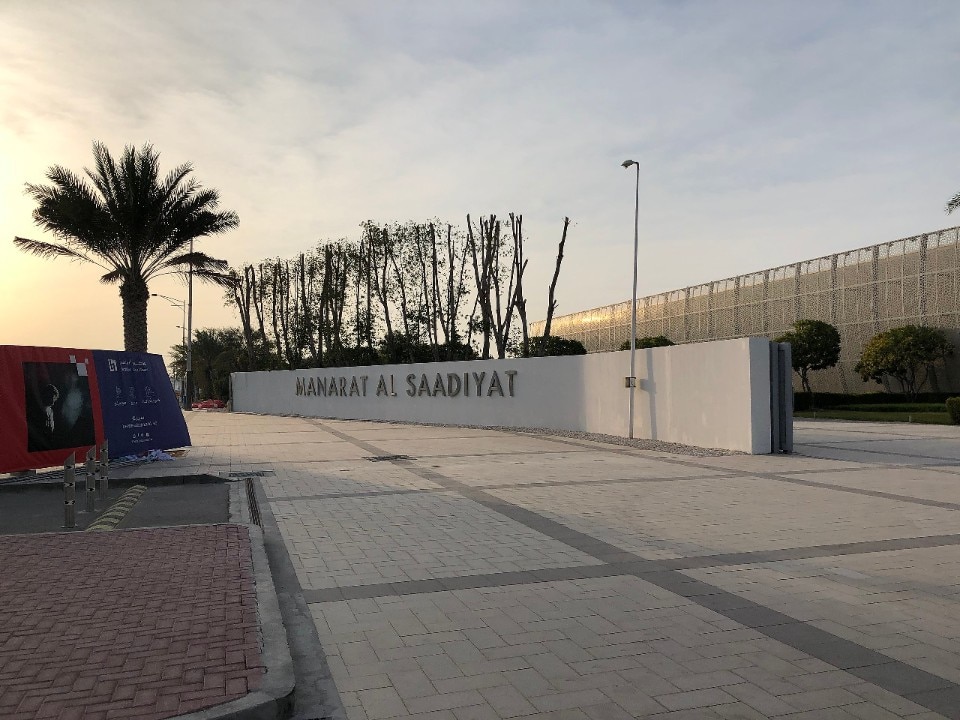
GCAM, Gluckman Tang Architects, Manarat Al Saadiyat, 2010
Opened in 2010 as the first centre for art and culture in the Al Saadiyat district, Manarat Al Saadiyat houses exhibition spaces, studios, workshops, photography studios, an auditorium, a terrace for outdoor events, a cafeteria and a shop. Besides being a renowned cultural centre with a rich agenda of temporary exhibitions, the centre offers a programme of activities to encourage social cohesion and the active involvement of the community in cultural practice. The simple and functional orthogonal structure clearly marks out the exhibition spaces enclosed by essential volumes, screened by a perforated metal curtain reminiscent of a mashrabiyya.
Photo Davide Mauro via Wikipedia

Ateliers Jean Nouvel, Louvre Abu Dhabi 2017
"It is a project based on one of the main symbols of Arab architecture: the dome. But here, in a clear shift from tradition, the dome is a modern proposal". With these words, Jean Nouvel describes the Louvre Abu Dhabi in Al Saadiyat, an offshoot of the Parisian museum that draws a bridge between the Arab world and Western culture.
Photo creativefamily via Adobe Stock
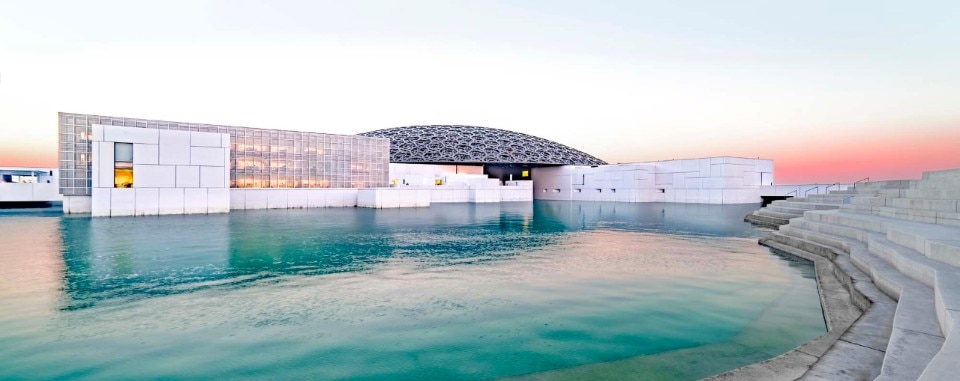
Ateliers Jean Nouvel, Louvre Abu Dhabi 2017
The complex is composed by 55 lowered volumes distributed over an artificial archipelago amid which pathways, squares and watercourses snake. To bring together these disjointed elements, which recall the layout of an ancient Medina, there is the gigantic dome composed of four outer layers clad in stainless steel and four inner layers clad in aluminium, separated by a steel structure: the eight superimposed layers, perforated by geometric figures of various sizes and angles, filter the sun suggesting the woven palm leaf roofs of traditional huts and create a diffuse "shower of light" with changing effects, evoking the chiaroscuro poetics of the Institut du Monde Arabe in Paris.
Photo solkafa via Adobe Stock
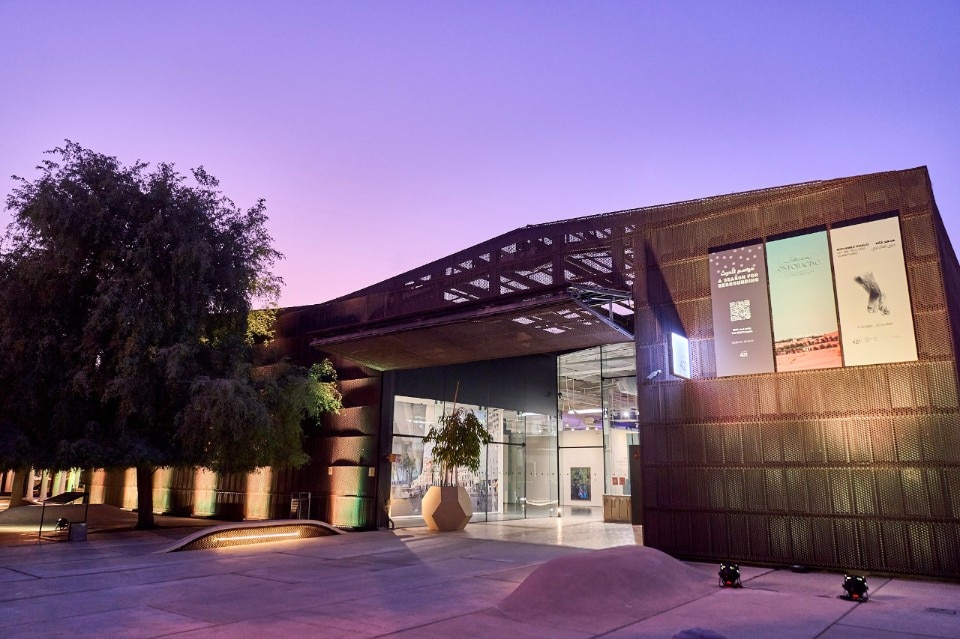
421 Art Campus, 2015
421 Art Campus is a platform for research, learning and experimentation for emerging artists and creatives of the Region, located in two renovated warehouses in Mina Zayed; 421 also focuses on sedimenting social cohesion in the neighbourhood by involving the community in artistic practice. The project has respected the industrial spirit of the district, enriching it with suggestions borrowed from Arab culture.
Courtesy 421
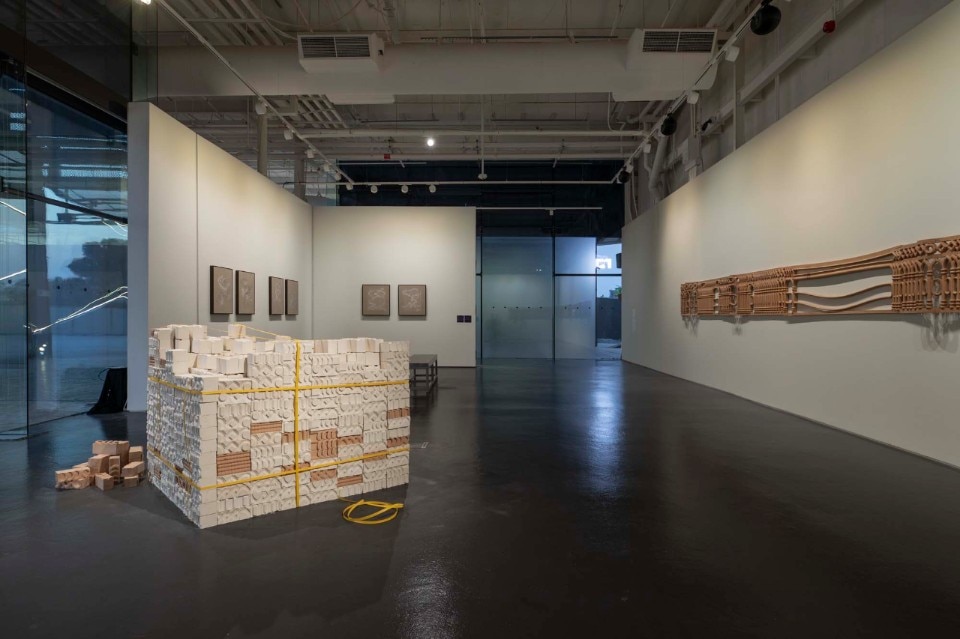
421 Art Campus, 2015
The complex houses galleries, studios, co-working spaces, a library, a café, a shop, a space for permanent installations and a multifunctional open-air square. Essential exhibition spaces alternate with courtyards with native vegetation. The buildings are wrapped in a perforated cor-tén shell that echoes the rusty texture of the surrounding warehouses.
Courtesy 421

GCAM, Gluckman Tang Architects, Manarat Al Saadiyat, 2010
Opened in 2010 as the first centre for art and culture in the Al Saadiyat district, Manarat Al Saadiyat houses exhibition spaces, studios, workshops, photography studios, an auditorium, a terrace for outdoor events, a cafeteria and a shop. Besides being a renowned cultural centre with a rich agenda of temporary exhibitions, the centre offers a programme of activities to encourage social cohesion and the active involvement of the community in cultural practice. The simple and functional orthogonal structure clearly marks out the exhibition spaces enclosed by essential volumes, screened by a perforated metal curtain reminiscent of a mashrabiyya.
Photo Davide Mauro via Wikipedia

Ateliers Jean Nouvel, Louvre Abu Dhabi 2017
"It is a project based on one of the main symbols of Arab architecture: the dome. But here, in a clear shift from tradition, the dome is a modern proposal". With these words, Jean Nouvel describes the Louvre Abu Dhabi in Al Saadiyat, an offshoot of the Parisian museum that draws a bridge between the Arab world and Western culture.
Photo creativefamily via Adobe Stock

Ateliers Jean Nouvel, Louvre Abu Dhabi 2017
The complex is composed by 55 lowered volumes distributed over an artificial archipelago amid which pathways, squares and watercourses snake. To bring together these disjointed elements, which recall the layout of an ancient Medina, there is the gigantic dome composed of four outer layers clad in stainless steel and four inner layers clad in aluminium, separated by a steel structure: the eight superimposed layers, perforated by geometric figures of various sizes and angles, filter the sun suggesting the woven palm leaf roofs of traditional huts and create a diffuse "shower of light" with changing effects, evoking the chiaroscuro poetics of the Institut du Monde Arabe in Paris.
Photo solkafa via Adobe Stock

421 Art Campus, 2015
421 Art Campus is a platform for research, learning and experimentation for emerging artists and creatives of the Region, located in two renovated warehouses in Mina Zayed; 421 also focuses on sedimenting social cohesion in the neighbourhood by involving the community in artistic practice. The project has respected the industrial spirit of the district, enriching it with suggestions borrowed from Arab culture.
Courtesy 421

421 Art Campus, 2015
The complex houses galleries, studios, co-working spaces, a library, a café, a shop, a space for permanent installations and a multifunctional open-air square. Essential exhibition spaces alternate with courtyards with native vegetation. The buildings are wrapped in a perforated cor-tén shell that echoes the rusty texture of the surrounding warehouses.
Courtesy 421
For some years now, the Abu Dhabi government has been investing substantially in Al Saadiyat, a candidate to become one of the most important cultural districts on the planet. It is here where the most renowned international archistars converge (from Jean Nouvel with the Louvre Abu Dhabi, to Frank Gehry with the Guggenheim under construction, to Norman Foster and Mecanoo with the future Zayed National Museum and Natural History Museum respectively). In the Mina Zayed district, further away from the spotlight but no less bustling with activity, a massive process of urban regeneration is transforming the area of the old commercial port, whose main activities were relocated in 2012, into a dynamic multifunctional district where the spirit of the place lives on in the industrial buildings renovated to house spaces and services for the community.
Regardless of the specific characteristics of the locations, in both contexts Emirati pride can be seen not only in the desire to turn the spotlight on a lively and high-quality cultural scene but also on an increasingly dense and cohesive social fabric, thanks to programmes that bring the community closer to artistic and cultural practice.
05
Infrastructure and sustainability
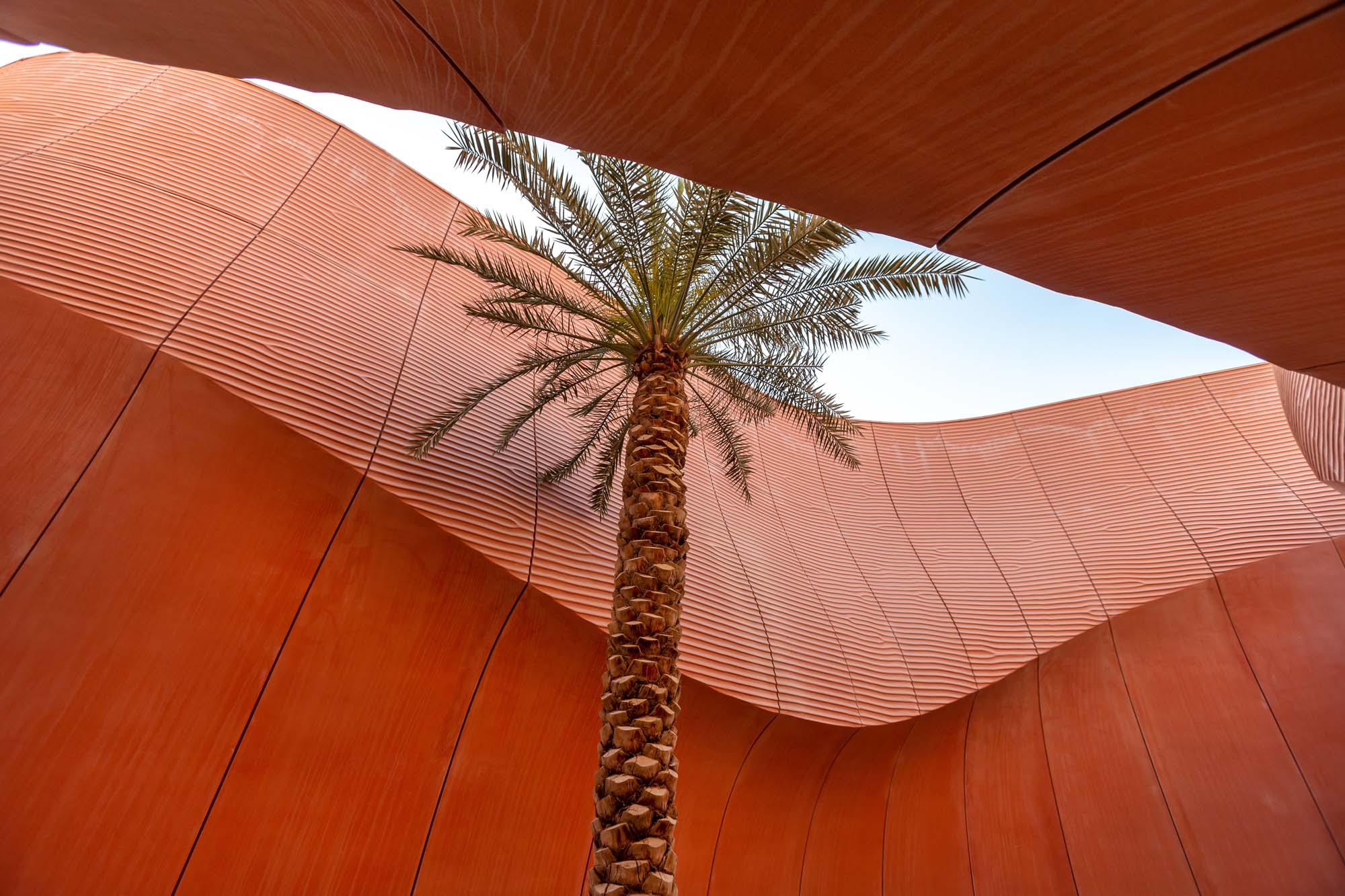
 View gallery
View gallery

Zaha Hadid Architects, Sheikh Zayed Bridge, 2010
The 842-metre-long bridge spanning the Maqtah Canal, connecting the island of Abu Dhabi with the mainland, is not only a strategic urban infrastructure for vehicular access to the capital but a clearly recognisable landmark in the area.
Photo manowar 1973 da Adobe Stock
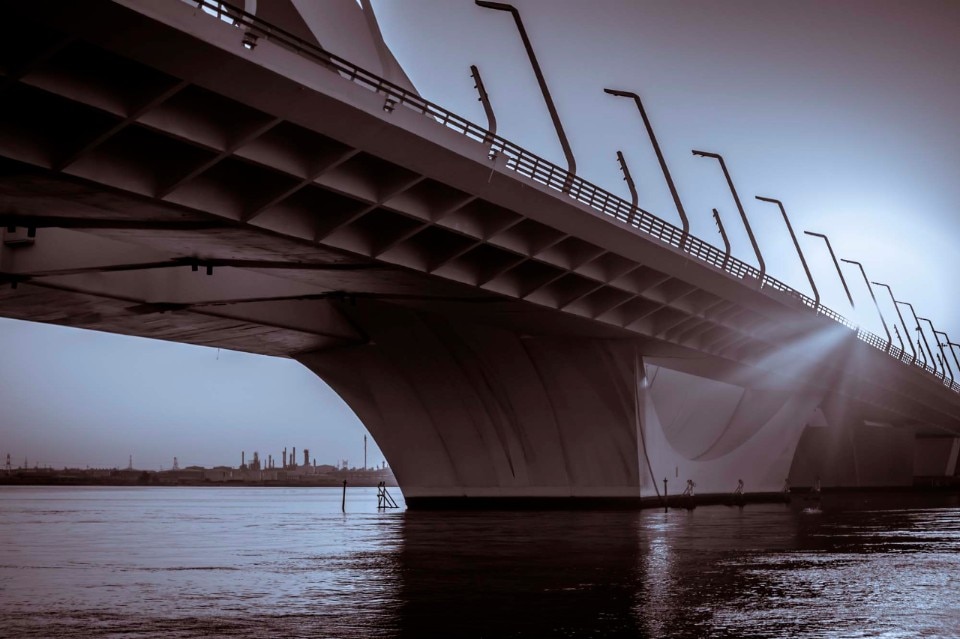
Zaha Hadid Architects, Sheikh Zayed Bridge, 2010
The two road levels, each with four lanes, are supported by an entirely pre-stressed concrete structure with a fluid and dynamic silhouette reminiscent of desert dunes. The dramatic night lighting accentuates the sculptural character of the construction
Photo Yogen da Adobe Stock
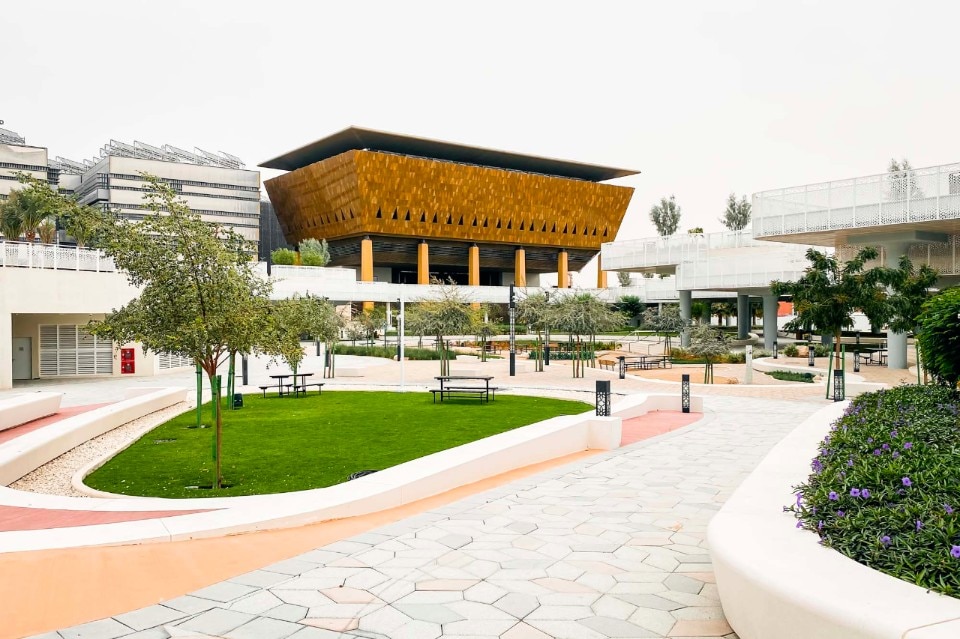
Foster + Partners, Masdar City, 2006-ongoing
The project for a settlement of about 50,000 inhabitants, located in the desert 30 km from the capital, was launched by the government to promote non-oil energy production technologies and make the region an international benchmark in the field of environmental sustainability.
Photo solkafa da Adobe Stock
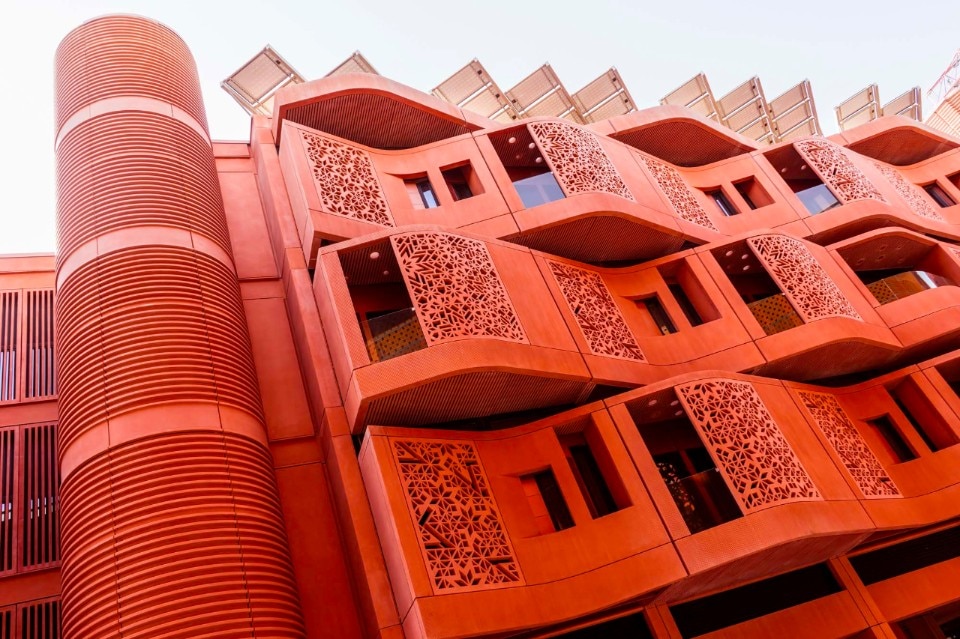
Foster + Partners, Masdar City, 2006-ongoing
The regular urban grid features residences, services, commercial and cultural spaces, and research and development centres, including the Masdar Institute of Science and Technology. The tree-lined squares, courtyards and shaded areas recall the settlement principles of the traditional Arab city, integrated with the most refined contemporary technologies: from the supply of energy exclusively from solar and wind power, to the total recycling of waste, to the elimination of fossil fuel vehicles.
Photo Evaldas da Adobe Stock

Zaha Hadid Architects, Sheikh Zayed Bridge, 2010
The 842-metre-long bridge spanning the Maqtah Canal, connecting the island of Abu Dhabi with the mainland, is not only a strategic urban infrastructure for vehicular access to the capital but a clearly recognisable landmark in the area.
Photo manowar 1973 da Adobe Stock

Zaha Hadid Architects, Sheikh Zayed Bridge, 2010
The two road levels, each with four lanes, are supported by an entirely pre-stressed concrete structure with a fluid and dynamic silhouette reminiscent of desert dunes. The dramatic night lighting accentuates the sculptural character of the construction
Photo Yogen da Adobe Stock

Foster + Partners, Masdar City, 2006-ongoing
The project for a settlement of about 50,000 inhabitants, located in the desert 30 km from the capital, was launched by the government to promote non-oil energy production technologies and make the region an international benchmark in the field of environmental sustainability.
Photo solkafa da Adobe Stock

Foster + Partners, Masdar City, 2006-ongoing
The regular urban grid features residences, services, commercial and cultural spaces, and research and development centres, including the Masdar Institute of Science and Technology. The tree-lined squares, courtyards and shaded areas recall the settlement principles of the traditional Arab city, integrated with the most refined contemporary technologies: from the supply of energy exclusively from solar and wind power, to the total recycling of waste, to the elimination of fossil fuel vehicles.
Photo Evaldas da Adobe Stock
We finally explore the urban and territorial infrastructures that make the Emirate a place of ceaseless engineering, technological and scientific innovation.
The city of Abu Dhabi is literally an island, located less than 250 metres from the coast and joined to the continent by the Maqta and Mussafa bridges and by the Sheikh Zayed bridge, designed by Zaha Hadid: for those arriving by car, this sculptural and dramatically lit bridge acts as a visiting card to the dynamic and bustling city to which it leads.
Some thirty kilometres away in the middle of the desert, Masdar City, on a masterplan by Norman Foster, is the realised utopia of a city with zero waste and zero carbon emissions, in a country that has always built its fortune on oil and that looks to the future with a new perspective.


